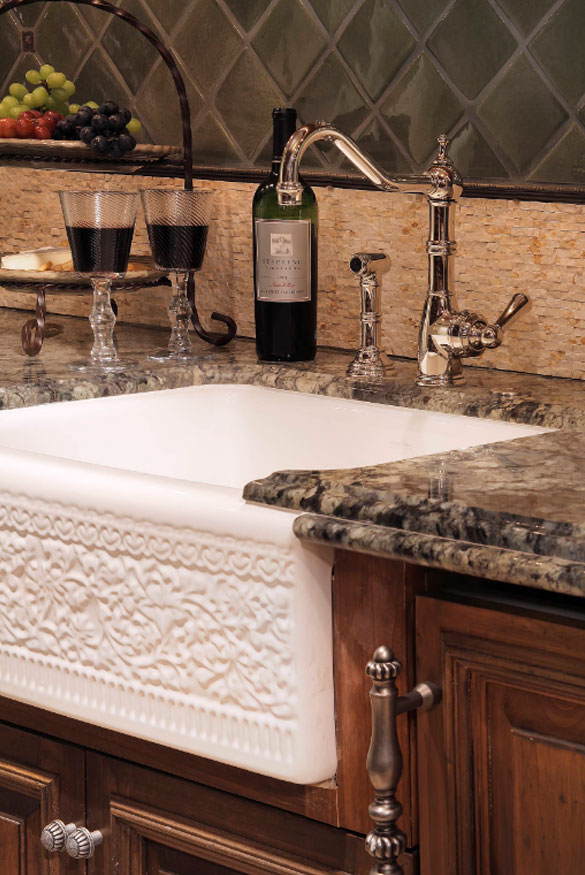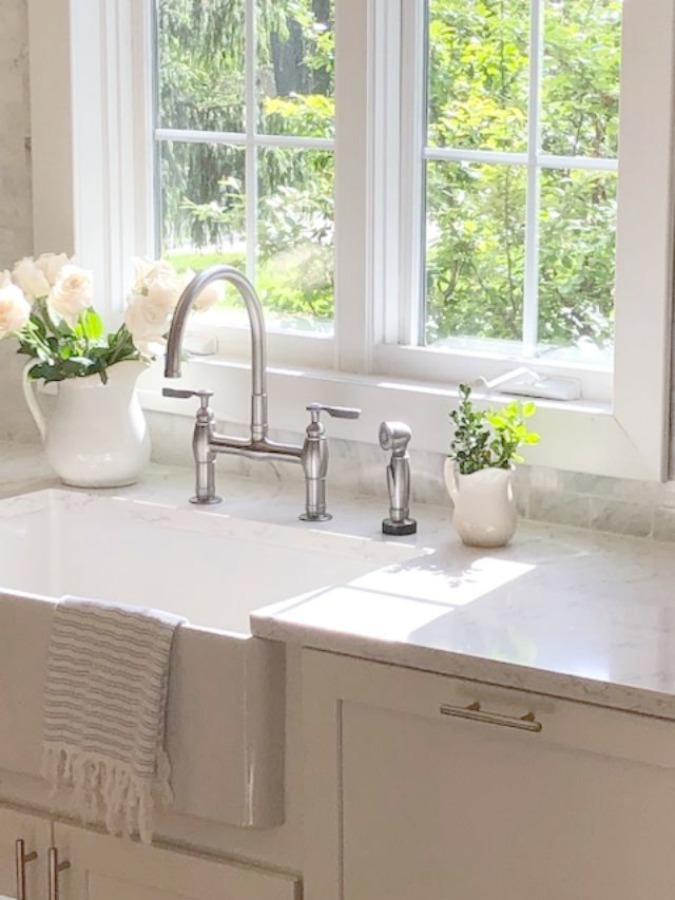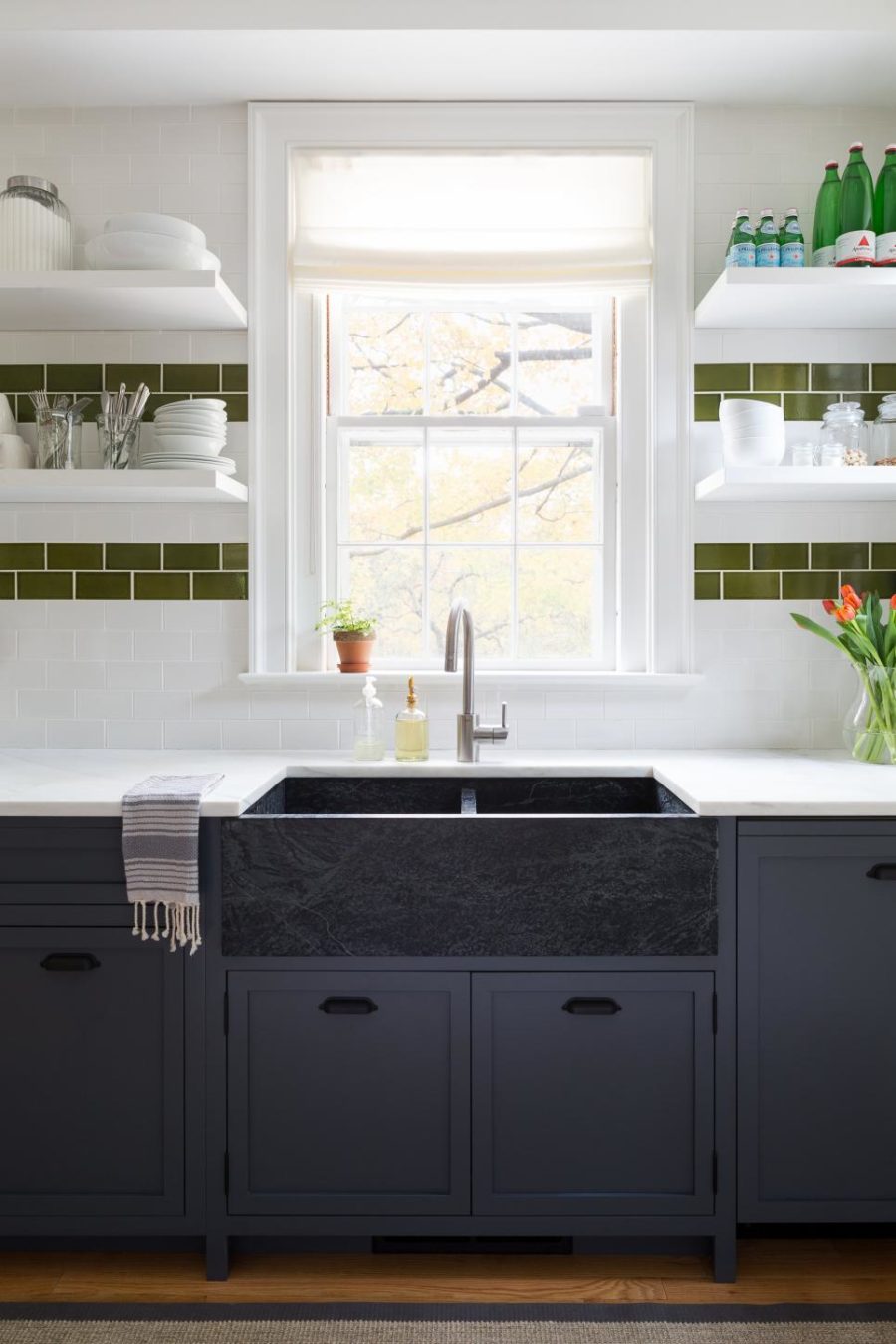A rustic farmhouse kitchen sink is a timeless addition that brings charm, functionality, and a touch of country living to any kitchen. Known for its deep basin, apron front, and durable construction, this style of sink has become increasingly popular in modern homes. This article will provide an in-depth look at rustic farmhouse kitchen sinks, including their history, materials, styles, installation tips, and maintenance. Additionally, we’ll explore common mistakes to avoid and answer frequently asked questions.
History and Appeal of Rustic Farmhouse Sinks

Historical Roots
Rustic farmhouse kitchen sinks have a rich history dating back to the late 17th and early 18th centuries. Originally, these sinks were crafted from stone or fireclay and designed for heavy-duty use in rural farmhouses. Their deep basins were ideal for washing large pots, pans, and even laundry. The apron front design protected cabinetry from water damage and added a distinctive aesthetic element.
Timeless Aesthetic
The appeal of the rustic farmhouse sink lies in its timeless aesthetic. Its classic design complements various kitchen styles, from traditional to modern rustic. The exposed apron front creates a focal point, adding visual interest and a sense of nostalgia. This blend of form and function makes the rustic farmhouse sink a beloved choice for homeowners seeking both practicality and style.
Modern Adaptations
While the basic design of farmhouse sinks remains unchanged, modern adaptations have introduced new materials, finishes, and features. Stainless steel, copper, and cast iron are now popular materials alongside traditional fireclay. These sinks also come with accessories such as cutting boards, drying racks, and colanders, enhancing their functionality. Despite these innovations, the rustic charm and practicality remain central to their appeal.

Versatility in Design
Rustic farmhouse sinks are incredibly versatile, fitting seamlessly into various kitchen designs. Whether your kitchen features sleek, modern lines or warm, country aesthetics, a farmhouse sink can enhance the overall look. The variety of materials and finishes available allows for customization, ensuring the sink complements your cabinetry, countertops, and overall decor.
Functional Benefits
Beyond aesthetics, rustic farmhouse sinks offer numerous functional benefits. The deep basin allows for easy washing of large pots and pans, while the apron front provides ergonomic advantages, reducing the need to lean forward. This design also minimizes water splashing onto countertops, making clean-up more efficient. Additionally, the durable materials used in these sinks ensure longevity and resistance to wear and tear.
Increasing Home Value
Installing a rustic farmhouse sink can also increase your home’s value. Potential buyers often appreciate the blend of functionality and style that these sinks provide. A well-chosen farmhouse sink can serve as a standout feature in your kitchen, attracting attention and adding to the overall appeal of your home. This makes it a worthwhile investment for homeowners considering resale value.

Materials and Styles
Fireclay Sinks
Fireclay is a traditional material for farmhouse sinks, known for its durability and classic look. These sinks are made by molding clay, glazing it, and then firing it at high temperatures. The result is a non-porous, scratch-resistant, and stain-resistant surface. Fireclay sinks come in various colors and finishes, from glossy white to matte black, allowing for customization to match your kitchen decor.
Cast Iron Sinks
Cast iron sinks are another popular option, prized for their strength and durability. These sinks are coated with a layer of enamel, which provides a smooth, glossy finish and enhances their resistance to stains and scratches. Cast iron farmhouse sinks are available in a range of colors, adding a touch of elegance to any kitchen. However, they are quite heavy and may require additional support during installation.
Stainless Steel Sinks
For a more contemporary look, stainless steel farmhouse sinks are an excellent choice. These sinks are durable, easy to clean, and resistant to heat and stains. Stainless steel sinks can complement both modern and traditional kitchen designs. They are available in various gauges, with thicker steel offering greater durability and noise reduction. The sleek, industrial look of stainless steel can add a modern touch to a rustic kitchen.

Copper Sinks
Copper farmhouse sinks are renowned for their unique aesthetic and antimicrobial properties. Over time, copper develops a natural patina that adds character and depth to the sink. These sinks are available in various finishes, from shiny to weathered, allowing for customization. However, copper is softer than other materials and can develop scratches and dents with heavy use. Regular maintenance is required to preserve its appearance.
Granite Composite Sinks
Granite composite sinks offer the look of natural stone with enhanced durability. Made from a combination of granite stone dust and acrylic resins, these sinks are resistant to scratches, stains, and heat. Granite composite sinks are available in various colors and textures, providing a natural, earthy look that complements rustic kitchens. Their non-porous surface also makes them easy to clean and maintain.
Custom Finishes and Designs
Beyond these common materials, rustic farmhouse sinks can be customized with various finishes and designs. Hand-painted designs, hammered textures, and unique shapes add a personal touch to your kitchen. Custom sinks can be crafted to fit specific dimensions or design preferences, ensuring a perfect match for your kitchen. This level of customization allows for a truly unique and personalized kitchen feature.

Installation Tips
Pre-Installation Considerations
Before installing a rustic farmhouse sink, there are several considerations to keep in mind. First, ensure that your cabinetry can support the weight of the sink, especially if you choose a heavy material like cast iron or fireclay. You may need to reinforce the cabinets or install additional support brackets. Also, consider the dimensions of the sink and ensure it fits within your existing countertop and cabinetry layout.
Measuring and Cutting
Accurate measuring and cutting are crucial for a successful installation. Measure the sink’s dimensions carefully, including the apron front, basin depth, and width. Mark these measurements on your countertop and cabinetry, ensuring a precise fit. Use appropriate tools, such as a jigsaw or circular saw, to cut the countertop and create the necessary openings. Double-check all measurements before making any cuts to avoid errors.
Installing the Sink
Begin the installation by placing the sink into the opening to ensure it fits properly. Apply a bead of silicone sealant around the edges of the opening to create a watertight seal. Carefully lower the sink into place, pressing it firmly to ensure a secure fit. Use a level to ensure the sink is even, making adjustments as needed. Allow the sealant to dry completely before proceeding with the next steps.

Securing the Sink
To secure the sink, install mounting brackets or clips as specified by the manufacturer. These brackets help to hold the sink in place and provide additional support. Ensure that the sink is level and properly aligned with the countertop before tightening the brackets. Check for any gaps or uneven areas and make necessary adjustments. A securely installed sink will prevent movement and ensure longevity.
Connecting Plumbing
Once the sink is securely in place, connect the plumbing. Attach the drain assembly and garbage disposal (if applicable), ensuring all connections are tight and leak-free. Connect the water supply lines to the faucet, following the manufacturer’s instructions. Test the plumbing connections by running water and checking for leaks. Make any necessary adjustments to ensure a watertight fit.
Final Touches
After the sink is installed and the plumbing is connected, complete the installation with final touches. Install the faucet and any additional accessories, such as a soap dispenser or sprayer. Apply a bead of silicone sealant around the edges of the sink where it meets the countertop, creating a watertight seal. Clean the sink and surrounding area to remove any debris or excess sealant. Your rustic farmhouse sink is now ready for use.

Maintenance and Care
Cleaning Fireclay and Cast Iron Sinks
Fireclay and cast iron sinks are known for their durability, but they still require regular cleaning to maintain their appearance. Use a mild dish soap and a soft cloth or sponge to clean the surface. Avoid abrasive cleaners and scouring pads, which can damage the finish. For stubborn stains, use a mixture of baking soda and water or a non-abrasive cleaner. Rinse thoroughly and dry with a soft cloth to prevent water spots.
Maintaining Stainless Steel Sinks
Stainless steel sinks are easy to maintain and resist stains and rust. Clean the sink regularly with mild dish soap and a soft cloth or sponge. Avoid using steel wool or abrasive cleaners, which can scratch the surface. For a deeper clean, use a mixture of baking soda and water or a stainless steel cleaner. Rinse thoroughly and dry with a soft cloth to prevent water spots and maintain the sink’s shine.
Caring for Copper Sinks
Copper sinks require special care to maintain their unique appearance. Clean the sink with a mild dish soap and a soft cloth or sponge. Avoid abrasive cleaners and acidic substances, which can damage the finish. To preserve the patina, use a copper cleaner and follow the manufacturer’s instructions. Regularly wax the sink with beeswax or carnauba wax to protect the surface and maintain its luster.

Granite Composite Sink Maintenance
Granite composite sinks are durable and easy to maintain. Clean the sink with a mild dish soap and a soft cloth or sponge. Avoid abrasive cleaners and scouring pads, which can damage the surface. For stubborn stains, use a mixture of baking soda and water or a non-abrasive cleaner. Rinse thoroughly and dry with a soft cloth to prevent water spots. Regularly seal the sink with a granite sealer to protect the surface.
Preventing Damage
To prevent damage to your rustic farmhouse sink, use a sink grid or mat to protect the surface from scratches and dents. Avoid placing hot pots or pans directly on the sink, as extreme temperatures can cause damage. Use cutting boards and avoid cutting directly on the sink surface. Regularly inspect the sink for any signs of damage or wear and address any issues promptly to maintain its appearance and functionality.
Addressing Common Issues
Common issues with farmhouse sinks include scratches, stains, and leaks. For scratches, use a non-abrasive cleaner and follow the manufacturer’s instructions for repair. For stains, use a mixture of baking soda and water or a non-abrasive cleaner. If you notice any leaks, check the plumbing connections and tighten as needed. Regular maintenance and prompt attention to issues will help to ensure the longevity of your rustic farmhouse sink.

Common Mistakes to Avoid
Choosing the Wrong Size
One of the most common mistakes is choosing a sink that is too large or too small for your kitchen space. Measure your countertop and cabinetry carefully to ensure the sink fits properly. Consider the size of your kitchen and the amount of counter space you need. A sink that is too large can overwhelm a small kitchen, while a sink that is too small may not provide the functionality you need.
Ignoring Weight Considerations
Rustic farmhouse sinks, especially those made of cast iron or fireclay, can be very heavy. Ignoring the weight considerations can lead to problems during installation and potential damage to your cabinetry. Ensure that your cabinets are reinforced and capable of supporting the weight of the sink. Consider consulting with a professional if you are unsure about the structural integrity of your cabinets.
Skipping Professional Installation
While it may be tempting to install the sink yourself, professional installation is often recommended for farmhouse sinks. These sinks require precise measurements, proper support, and secure plumbing connections. Skipping professional installation can lead to mistakes, such as improper alignment, leaks, and damage to your countertop and cabinetry. Investing in professional installation ensures a seamless and secure fit.
Overlooking Plumbing Requirements
Farmhouse sinks may require modifications to your existing plumbing, such as repositioning pipes and drains. Overlooking these requirements can result in improper installation and potential plumbing issues. Ensure that you understand the plumbing requirements for your sink and make any necessary adjustments before installation. Consult with a professional plumber if needed to ensure proper plumbing connections.
Neglecting to Check for Level
Ensuring that the sink is level is crucial for proper installation and functionality. Neglecting to check for level can result in water pooling, improper drainage, and an uneven appearance. Use a level during installation to ensure the sink is properly aligned. Make adjustments as needed to achieve a level fit and prevent issues down the line.
Using Harsh Cleaners
Using harsh cleaners on your farmhouse sink can damage the finish and reduce its lifespan. Avoid abrasive cleaners, scouring pads, and acidic substances that can scratch or tarnish the surface. Instead, use mild dish soap and a soft cloth or sponge for regular cleaning. Follow the manufacturer’s recommendations for cleaning and maintenance to preserve the sink’s appearance and functionality.

What is the best material for a rustic farmhouse kitchen sink?
The best material for a rustic farmhouse kitchen sink depends on your preferences and needs. Fireclay is a traditional, durable option with a classic look. Cast iron offers strength and a glossy finish. Stainless steel provides a contemporary, easy-to-clean option. Copper adds a unique aesthetic and antimicrobial properties. Granite composite offers the look of natural stone with enhanced durability. Consider your kitchen style, maintenance preferences, and budget when choosing a material.
How do I maintain the finish of my copper farmhouse sink?
To maintain the finish of your copper farmhouse sink, clean it regularly with mild dish soap and a soft cloth or sponge. Avoid abrasive cleaners and acidic substances. To preserve the patina, use a copper cleaner and follow the manufacturer’s instructions. Regularly wax the sink with beeswax or carnauba wax to protect the surface and maintain its luster. Address any scratches or dents promptly to prevent further damage.
Can I install a rustic farmhouse sink in an existing countertop?
Yes, you can install a rustic farmhouse sink in an existing countertop, but it may require modifications. Measure the sink and mark the dimensions on the countertop. Use appropriate tools to cut the countertop and create the necessary openings. Ensure that your cabinetry can support the weight of the sink and reinforce it as needed. Professional installation is recommended to ensure a seamless fit and proper plumbing connections.
What are the benefits of a deep basin farmhouse sink?
A deep basin farmhouse sink offers several benefits. It provides ample space for washing large pots and pans, making it ideal for busy kitchens. The deep basin reduces splashing, keeping countertops cleaner and dryer. It also offers ergonomic advantages, reducing the need to lean forward. The large capacity and functional design make deep basin farmhouse sinks a practical choice for both traditional and modern kitchens.
How can I prevent scratches on my farmhouse sink?
To prevent scratches on your farmhouse sink, use a sink grid or mat to protect the surface. Avoid placing sharp or heavy objects directly on the sink. Use cutting boards and avoid cutting directly on the sink surface. Clean the sink regularly with mild dish soap and a soft cloth or sponge. Avoid abrasive cleaners and scouring pads. Regularly inspect the sink for any signs of damage and address issues promptly.
Is a farmhouse sink a good investment for my kitchen?
Yes, a farmhouse sink is a good investment for your kitchen. It offers a blend of functionality and style, enhancing both the appearance and practicality of your kitchen. The timeless design and durable materials make it a long-lasting addition. Installing a farmhouse sink can also increase your home’s value, attracting potential buyers. Consider your kitchen style, needs, and budget when choosing a farmhouse sink to ensure it meets your requirements.

Related Posts: